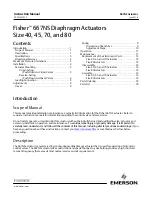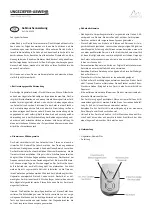
Instruction Manual
D102603X012
667NS Actuator
June 2018
12
All maintenance operations can be performed with the valve in the line.
WARNING
Avoid personal injury or property damage from sudden release of process pressure or bursting of parts. Before performing
any maintenance operations:
D
Do not remove the actuator from the valve while the valve is still pressurized.
D
Always wear protective gloves, clothing, and eyewear when performing any maintenance operations to avoid personal
injury.
D
Disconnect any operating lines providing air pressure, electric power, or a control signal to the actuator. Be sure the
actuator cannot suddenly open or close the valve.
D
Use bypass valves or completely shut off the process to isolate the valve from process pressure. Relieve process pressure
from both sides of the valve. Drain the process media from both sides of the valve.
D
Vent the power actuator loading pressure and relieve any actuator spring precompression.
D
Use lock‐out procedures to be sure that the above measures stay in effect while you work on the equipment.
D
The valve packing box may contain process fluids that are pressurized,
even when the valve has been removed from the
pipeline.
Process fluids may spray out under pressure when removing the packing hardware or packing rings, or when
loosening the packing box pipe plug.
D
Check with your process or safety engineer for any additional measures that must be taken to protect against process
media.
Replacement of Elastomeric Parts
Size 40, 45, and 70 Actuators
Perform the following if you are replacing only the elastomeric parts of the 667NS actuator, and no other maintenance
is necessary. The diaphragm, the gasket, and the seal bushing O‐rings are the only elastomeric parts in the size 40, 45,
and 70 actuators. Key number references are shown in figure 2 for size 40 and 45 actuators and in figure 3 for size 70
actuators.
1. Isolate the control valve from the line pressure, release pressure from both sides of the valve body, and drain the
process media from both sides of the valve. Reduce the actuator loading pressure to atmospheric pressure.
2. Remove the diaphragm casing cap screws and nuts (keys 13 and 14), and lift off the upper diaphragm casing
(key 1).
CAUTION
Do not allow the valve stem to rotate during this operation since it could cause damage to the valve seats.
3. Remove the diaphragm plate cap screw and spacer (key 12 and 2). For actuator sizes 40 and 45, place a wrench on
the actuator‐valve stem connector assembly (key 31) to prevent the actuator stem (key 144) from rotating during
the loosening of the diaphragm plate cap screw (key 12).
4. Take out the diaphragm (key 3), the upper diaphragm plate (key 4), and the lower diaphragm plate (key 71).
5. Remove the snap ring (key 72), and pull out the seal bushing (key 7). The seal bushing has two 1/4‐20 UNC tapped
holes provided in its top surface to be used as an aid in removing it.










































